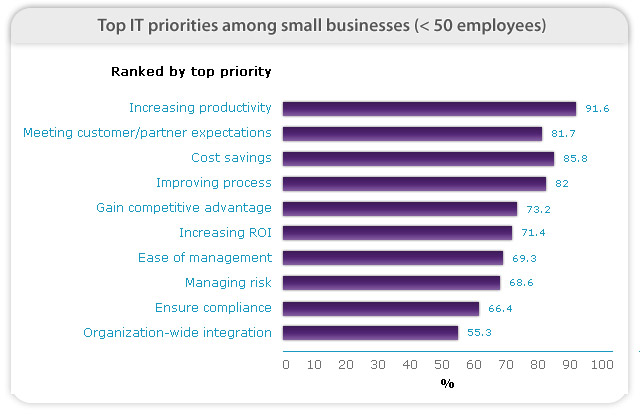SMBs move to create mobile workforce

More small and midsize businesses (SMBs) are looking to tap the advantages of having a mobile workforce by looking into areas that will make this work arrangement possible.
Among the findings unraveled by ZDNet Asia's IT Priorities 2010 survey, security enhancement, mobile working solutions and integrated enterprise-wide information access are the top three focus areas that SMBs plan to adopt in their IT strategies for the year.
The results are based on an online survey involving 438 Asian IT professionals across a spectrum of specialties including security, network and database. Small companies are regarded as those with two to 49 employees, while midsized ones are staffed with 50 to 999 people. Large enterprises have more than 1,000 workers in their books.
Security enhancements garnered the most votes among SMB participants, with more than 68 percent of small companies identifying this as their top IT strategy. Responses from midsized firms ranged from 56.3 to 66.7 percent.
The two groups differed on their second most important strategic thrust. Small companies viewed mobile working solutions as more important, whereas medium-sized firms consider integrated enterprise-wide information access as their next top priority.
Large enterprises generally considered virtualization as their IT strategy's main focus. Of this, 63 percent among the category of 1,000 to 9,999 employees planned to improve on their datacenter management, while 69.6 percent in the 10,000 and more segment had similar intentions. Small companies saw this as 10th on their list of priorities, while midsized firms ranked it 6th.

Patrick Chan, IDC's chief technology advisor, attributed the need for a mobile workforce to SMBs often requiring their employees to take on multiple roles within the company. These people would typically have to be more mobile in their processes and execution.
As for security, he said: "Newer SMBs are beginning to leverage Web 2.0 tools to engage, albeit many in Asia are still early in the cycle. Therefore, security tends to be a big issue where there are loosely bound operational processes."
Chan did note that these priorities may shift in countries where the mobile and broadband infrastructure is mature. "SMBs [in these places] are reducing branch infrastructure footprints and turning to the mobile workforce execution model," he said, citing an example of companies in the logistics industry equipping their employees with handheld devices to work more efficiently.
Meanwhile, Michael Barnes, vice president of software and Asia-Pacific research for Springboard Research, said the emphasis on security, mobility and accessible information by SMBs reflect a "well-targeted or narrowly focused drive to ensure flexibility, agility, reliability and responsiveness to customer demands".
Interestingly, the meeting of customer and partner expectations is regarded as a key IT objective for small companies, but not by midsize companies. Of the former, 86.1 percent (of companies with fewer than 50 employees) and 77.3 percent (of companies with 50 to 999 employees) of participants ranked this as second behind utilizing IT to increase productivity.
"For small companies, IT objectives are usually a direct reflection of business objectives. Small companies have limited resources and must focus squarely on meeting short-term, often immediate business requirements," Barnes said. "These companies very rarely have time to spend on more strategic, longer-term objectives such as improving processes."
IDC's Chan concurred. He pointed out that small companies usually derive critical revenue streams from customer and partner channels, which is why a majority of these firms spend time addressing these areas rather than operational efficiencies.